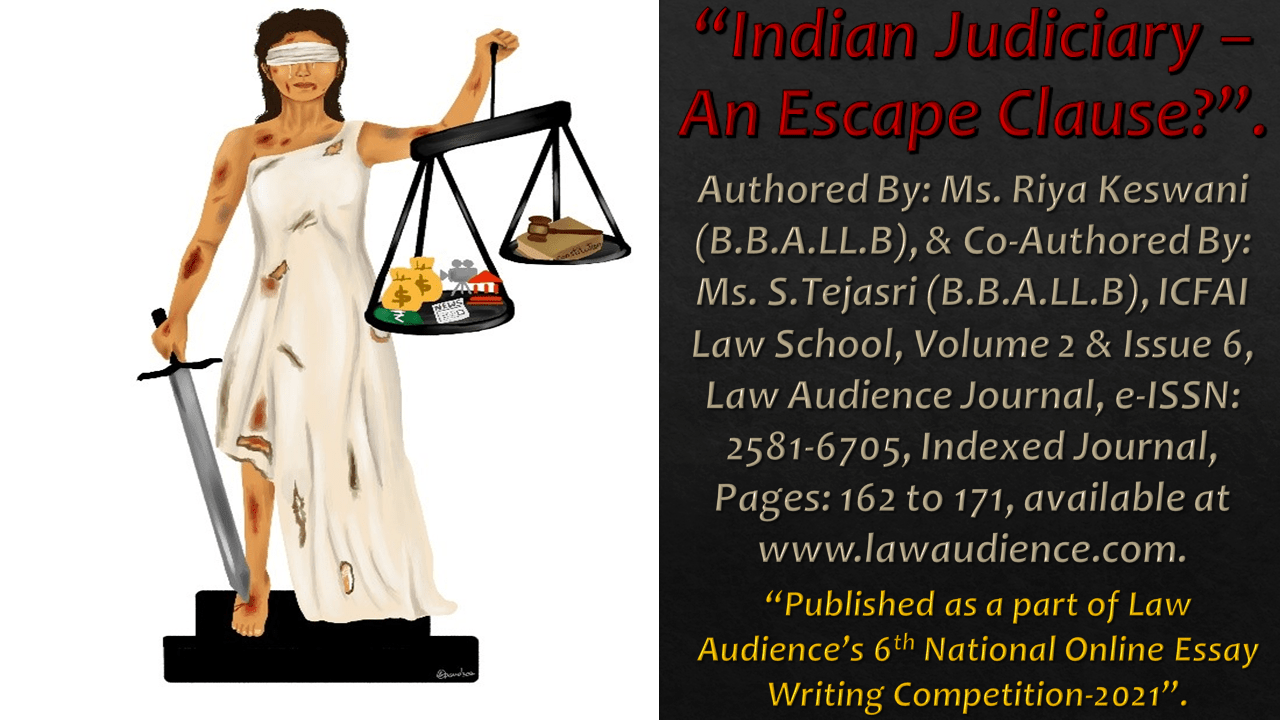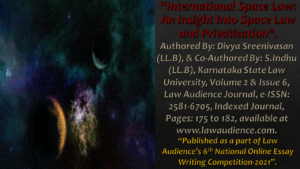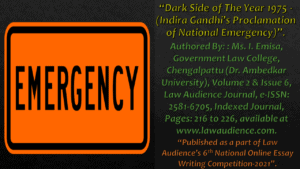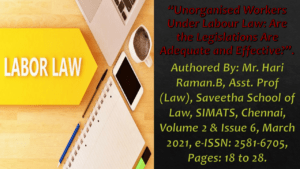Click here to download the full paper (PDF)
Authored By: Ms. Riya Keswani (B.B.A.LL.B), & Co-Authored By: Ms. S.Tejasri (B.B.A.LL.B), ICFAI Law School,
Click here for Copyright Policy.

“Image Credits:
Spandana Urlam & Riya Keswani”
I. INTRODUCTION:
“Justitia, a roman art that symbolized the moral forces of the justice system in Rome over centuries ago, which is also known as the justice lady has developed over the years taking different forms in different countries. In India, the concept of personification of justice has been there since time immemorial. The sculpture which once represented the power of the justice system and gave hope to the people for justice has now lost its meaning and has become the victim of the justice system. The question that we need to ask is how did the justice lady get injured so badly and fall into this critical state? Well, the answer is quite simple. She succumbed to the loopholes of the justice system”.
II. MAJOR LOOPHOLES:
II.I JUSTICE DELAYED IS JUSTICE DENIED:
The structure of the Indian judiciary comes from the Indian constitution and its preamble. It is the longest written constitution and guarantees various fundamental rights to its citizens. One of the fundamental rights guaranteed in the constitution is the “right to life and personal liberty” which states that “no one should be deprived of life and liberty except in accordance with law”[1], such right, gave birth to a speedy trial – the most important and equally ignored fundamental right. It is a known fact that disposal of a case has to be as soon as possible, in order to bypass all the grievance and mental agony caused due to the delay but the facts and the statistics paint a completely different picture.
The table presented below shows the number of cases pending in the hierarchal courts in India[2];
| DATE: | SUPREME COURT: | HIGH COURT: | DISTRICT/SUBORDINATE COURT: |
| DEC 2018 | 56,994 | 49.79 Lakh | 2.92 Crore |
| MARCH 2020 | 60,603 | 46.63 Lakh | 3.21 Crore |
| JAN 2021 | 65,086 | 56,62 Lakh | 3.72 Crore |
| APR 2021 | 67.279 | 57,53 Lakh | 3.81 Crore |
Are we supposed to start believing that speedy trial is nothing but waiting for years to get a verdict? Firstly, the victim has to go through pain and trauma caused by the perpetrator but the trauma does not end there. After that comes the filing of the case, having uncountable long and tedious visits to the court, following the complex procedure laid down by the judiciary makes one relive the trauma. This results in a situation where all the efforts made by the victim to reconstruct his/her life goes into vain. Delay in justice gives sufficient time to the accused to play with the evidence, manipulate the witnesses to withdraw their statements. The entire purpose of the judiciary is to give relief to the victim but instead, it causes added pain and agony without the surety whether the criminal will be punished or not.
In the Nirbhaya Rape Case[3], the victim was brutally raped and mutilated by 6 men. The case shook the entire India, there was a huge social outrage demanding justice. After a long wait of 7 years, reacting to the hanging of the convicts, Nirbhaya’s mother said, “Justice has finally been done and women will definitely feel safer now”. This shows how the delaying tactics utilized by the culprits lead to nothing but a long-awaited journey of justice due to the available escape clause of appeals, bails, review petitions, etc.
In another, Disha Rape Case, a 26-year-old veterinary doctor of Hyderabad was raped and burned to death, following which the accused were killed in an encounter by the police within 9 days after the incident. Such a step was applauded by various segments of the public. The immediate action not only delivered justice at the right time but also restored the trust of people, nevertheless, it is one landmark example, yet there is an inordinate delay beyond public expectation in such cases which requires desperate measures for curbing the same.
II.II MEDIA:
Media has been playing a vital role in providing information to the people and shaping their opinion. As we are progressing into a digital era the influence that media has over people, especially over the young generation is enormous. It was the primary source of information that made people aware of what happening around the world, but in recent times the power that was given to the media is being misused for commercial gain. “Trial by media” is a popular trend in the media culture where the media forms the opinion of the public regarding an Incident even before the Judiciary is involved. They publish stories with half-baked truth in order to develop TRP. The platform which is supposed to represent nations’ true stories is instead involved in a major monopoly of fame and reputation.
II.II.I VICTIMS OF THE MEDIA:
II.II.I.I ACCUSED:
Whenever there is a case of sensitive nature, the media conducts a trial, which includes forming people’s opinions against the accused without considering the legal principle of “innocent until proven guilty beyond doubt”. Irrespective of the accused is guilty or not, he/she still has to face the ridicule and scrutiny of society. The media advertises its opinion based on public emotion and reaction. Even if the accused is proven innocent by the court, he still will always be guilty in the eyes of media and the society.
As of today, the judgment passed by a news channel has more impact on society. In a famous case i.e., Jessica Lal Murder Case[4], the effect of media trial was seen to be established in this country. A bartender was shot dead by the son of a high-profile person, media took this as an opportunity to expose the loopholes of the trail, sting operations of interviewing witness secretly, leaking the recordings of accused from police custody, etc., the Supreme Court of India accepted that there had been an element of “trial by media”.
The recent case of the death of Bollywood Actor Sushant Singh Rajput where the alleged accused i.e., his girlfriend Rhea Chakraborty was portrayed as a Murderer who was behind the death of the actor, even though viscera reports had given an affirmation to the cause of death being suicide. Due to media trials, she was subjected to widespread hatred that led to many sexist comments and slurs without any proof. Forcing her to file a plea in the Supreme Court against the unfair trial conducted by the media.[5]
II.II.I.II VICTIM:
Media generates information which is concocted by nature to grab attention nationwide to creating a sensation. Hence, they choose to produce high-profile cases and push the focus from victims who need their support. The other side of the same coin is that sometimes the victims do not wish to tell their stories out of the fear of shame that society will put them through or the fact that they are still struggling to process the pain and trauma that was inflicted on them. The facts are manipulated in such a way that puts the victim in a vulnerable position, sharing private information as to the past of the victim or finding fault of the victim which might have contributed to the crime.
For example, if a girl is raped or sexually assaulted, a lot of times the information that is printed deals with is what was she wearing or where was she coming from when she got raped. In cases of sensitive nature even if the victim is a child, their details are published with their photos, address, picture of the accused, or any details which can lead to the revelation of the victim. Even though according to media ethics and laws of journalism the personal details and names of the victim and their family members should not be published. The right to privacy is given much importance as one of the major fundamental rights theoretically, but in reality, the right to privacy is always in conflict with freedom of speech exercised by the media.
Such information which is supposed to be protected under the right to privacy is also published in the name of “freedom of speech”. These things have a traumatic effect on the victim and their family members. They are constantly intervened and disturbed by various media houses, friends, family, etc. which they might be ready to deal with and it only adds to their misery.
The case of Aarushi Talwar’s Murder[6], Aarushi was found dead in her bedroom, the housekeeper was suspected of her murder and subsequently, the housekeeper was also found dead on the terrace the very same day. Media, as usual, interfered with the investigation of this case with an opinion that the father of Aarushi has killed both of them as he saw both of them in a compromising position in her bedroom but this assumption was contradicting to the report given by CBI which said that no evidence could prove the involvement of Aarushi’s father in her murder, such unreasonable statements passed by media created prejudice in the mind of the public.
II.II.I.III CASES:
Media has a huge impact on the judicial proceedings, especially in high-profile cases as they have the power to glorify and intensify the details of the case. The right to a fair trial is a fundamental right that gets infringed by the media trials as they conduct their own investigation, give out important details of the case and exaggerate the facts. A lot of times the names of the witness and the evidence get leaked in the media, thus giving a chance to the accused to tamper with them making such evidence inadmissible. There is a chance of subconscious prejudice in the minds of the judges while delivering a judgment fearing protests from the public and backlashes media due to the trial which is already being conducted by media prior hand. In the case of state of Maharashtra vs. Rajendra Jawanmal Gandhi[7], the interference of media with the judicial procedure was enormous, hence the Supreme Court held that the trial by electronic media Press or by way of public education is anti-thesis to rule of law and can lead to a miscarriage of Justice.
In the famous Sanjay Dutt Case[8], the well-known actor was sentenced to five years of imprisonment for his involvement in the 1993 Mumbai serial blast by the Supreme Court of India, he was convicted on the ground that he kept an AK 56 hence he was charged under the terrorist and disruptive activities act but later the court had acquitted Sanjay Dutt of all charges under the Terrorist and Disruptive Activities (Prevention) Act, 1987, after it observed that he acquired the gun for self-defense and that he was not a terrorist. For Sanjay Dutt the only mistake was being a famous actor and hence the case was highlighted by media to such an extent that he was already named as a terrorist even before the final judgment this clearly explains the role of media trial in disruption of judicial proceedings.
II.III CORRUPTION:
Corruption exists in all the sectors and parts of India, due to various reasons but mostly because of the complexity of administrative procedures and economical and social inequality. According to the corruption report[9] conducted in 2018, Citizens perceived that among the public services, police services have a 40% increase in the level of corruption, and in police departments around 2% of the people were denied services for not paying the bribe. In another report of 2008[10], it claimed that 50% of the citizens had firsthand experience in paying bribes.
The data clearly shows how deep-rooted corruption is in our society. Even in the judiciary, we have strong cases of corruption. Corruption exists in our legal system because it is convenient for a judge to influence the decision of a fellow judge or apply pressure on subordinate courts. Judges have been given wide discretionary power which can be easily misused. Though there are several anti-corruption laws and the punishment is strict but there is no proper implementation. Citizens already find the judicial procedures very complex and the existence of loopholes makes it more difficult. Like already mentioned in the previous section, one of the major loopholes in our judiciary system is a delay in justice, the main reasons found for paying bribes were to get the hearing date of choice or to get a certified copy of the order[11]. In a case like this, a person is left with no choice other than to pay the bribe, because acting against a judge involves complex procedure.
For example, to remove a high court judge consent of CJI is required and to remove a Supreme Court judge, the president has to pass the order after it has been passed by both the houses with the majority of its members present and voting. Such procedural complexities make it impossible for a common man to take and action and the easier way out is just to pay the bribe.
In 1995, the Chief Justice of Bombay High Court i.e., A.M. Bhattacharjee received 70 lakhs as book advance from a publishing firm, which is known to have connections with the underground world, the moment this fact was proved he was forced to resign.[12]
II.IV ILLUSION OF EQUALITY:
Equality before law is a fundamental right guaranteed under the Indian Constitution which states “The State shall not deny any person equality before the law or the equal protection of the laws within the territory of India”[13] it means that everyone is equal in the eyes of law and they shall be protected under any circumstances. One of the rights guaranteed under article 14[14] and article 21[15] is access to justice. Which means that everybody should have a fair chance at getting justice, but in reality, access to justice depends on the wealth of the person.
II.IV.I IN CASE OF THE ACCUSED:
An accused with proper financial means can easily get bail through bail fee or bail bond which gives one ample time to plan and construct their case with the help of a defense lawyer at their convenience by keeping their personal life intact. Whereas someone who does not have the financial means as someone privileged has no choice but to serve jail time.
II.IV.II IN CASE OF THE VICTIM:
All the cases of criminal nature are represented by the state (by public prosecutors), to protect the interest of society at large. But due to the number of cases pending in court, lack of financial means, inadequate salaries, and part-time private practice prosecutors are overburdened and it makes it difficult to give equal importance to each case. Let’s consider a case where the accused is a financially privileged person and can hire a private lawyer with sufficient resources and adequate time to represent the case and on the other hand the victim has to go through the public prosecutor who may not be able to devote sufficient time due to various reasons stated above. In such a situation the interest of the victim is affected. In 2019, the state of Karnataka observed 38% shortage of public prosecutors, that only 488 Public prosecutors were handling 6.3 Lakh pending cases[16]. How can it be said that there is equal and fair access to justice when one party has better resources than other party? The conviction rate in India as per the data by the national crime records bureau of 2019 to be 50.400% clearly paints the picture of the efficiency of the courts and public prosecutors in India.
All the loopholes are interrelated to each other, they all are just different sides of the same dice.
III. SUGGESTIONS:
- ‘Ignorantia Juris Non Excuta’ means that ignorance of law is no excuse, it is presumed that everybody knows the law. This is a very essential principle of legal system but still, law is not part of the curriculum in schools which leads to situations of ignorance of the law. There are many instances where the rights of the people are infringed and they are not aware of it. Law should be included as a subject in schools to bring about awareness regarding the Indian judicial system. When people are educated about their rights they have a better chance at claiming them.
- According to Indian Justice Report[17], India spends less than 1% of its GDP towards judiciary, there is inadequate planning, lack of resources, and lack of infrastructure leading to the present condition of the judiciary in India. A sector that has such wide powers to punish the wrongdoers and give relief to the victim spends only 1% of India’s GDP whereas 3000 crores for the statue of “IRON MAN OF INDIA”. Hence there should be proper allocation of resources and budget planning so conditions can be improved.
- The provisions of law are very detailed but they lack execution, there is no proper implementation when required.
- As already established, the right to speedy trial is a fundamental right, but since there is no proper implementation it leads to the delay in the case. Hence, there should be a fixed time limit for the disposal of cases that will benefit the accused as well as the victim.
- Amid this pandemic, there was seen a big push towards digitization of the judicial process which should be continued in the future as it will not only increase the efficiency but also transparency.
- There should be strict laws and proper implementation where Media trials affect the cases by misusing the fundamental right of “freedom of speech and expression” guaranteed under the constitution.
- The victim should be given the status of a party and should be involved in the decisions taken in the case as the verdict not only affects the society at large but also the personal life of the victim. It will increase the faith of people in the judiciary.
- The Indian laws are very old, wherever the provisions are silent on a matter or there is ambiguity, judges interpret them according to their subjective knowledge which is different from different judges, thus they need to be reformed as some of the laws are not even relevant as of today.
IV. CONCLUSION:
It was in 1947 that India got freedom from all the overlong suffering, but the story does not end there. It took 300 minds to frame the guiding principles of every citizen, yet we are in a situation that nobody would have expected. All we hear and see are massive amounts of pending cases resulting in delayed justice. This goes against the basic and most important fundamental right of speedy trial, and the process is further made even more taxing because of the loopholes which act like termites in the judicial system.
We are surrounded by a plethora of crimes every day even after having the largest constitution which addresses every little concern, who is to blame? The people or the justice system? The ones who are supposed to be responsible for the implementation of all the laws made are the ones neglecting their responsibilities, and the end results are corrupted judges, delayed justice, trial by media, manipulative politics, and phantom of equality at the cost of the victim’s suffering. It’s high time everyone acknowledges the fact that law and Justice is not only for lawyers/accused/victims but also for every other citizen, whose duties and rights are to be known and claimed if and when required. Maybe that way, the factor of being responsible towards our nation will be given importance and Justice can be served.
Even though there are various legal papers, articles, and reports as to where the Indian judiciary is lacking, there are still no strict actions being taken. It is the need of the hour to improve the judiciary system which is the only ray of hope for citizens of India or we might find ourselves stranded in the utter darkness of injustice.
Footnotes:
[1] INDIA CONST. art. 21.
[2] Pradeep Thakur, Pending cases in India cross 4.4 crores, up 19% since last year, TOI, April 15, 2021.
[3] Mukesh v. NCT of Delhi, 2017 6 SCC 1.
[4] Manu Sharma v. NCT of Delhi, 2010 6 SCC 1.
[5] Prerna Lidhoo, Aarushi Talwar To Rhea Chakraborty: A Tale Of Two Media Trial And Zero Lessons Learnt, The Wire (Sept. 1, 2020), https://thewire.in/media/rhea-chakraborty-sushant-singh-rajput-aarushi-talwar-media-trial.
[6] Nupur Talwar v. CBI, 2012 11 SSC 465.
[7] 1997, SPL (Crl.) Nos. 2510/97.
[8] Sanjay Dutt v. State through CBI, SPL (Crl.) 1834-35 of 1994.
[9] Eminent Jurist Fali S. Nariman, CMS-INDIA CORRUPTION STUDY 2018, CMS (2018), https://www.im4change.org/siteadmin/tinymce/uploaded/India%20Corruption%20Study%202018%20by%20CMS.pdf.
[10] Indian Corruption study, 2008, https://transparencyindia.org/wp-content/uploads/2019/04/India-Corruptino-Study-2008.pdf.
[11] CORRUPTION REPORT, supra note 9 at 11.
[12] C. Ravichandran iyer v. Justice A.M. Bhattachrjee, 1995, 5 SCC 457.
[13] INDIA CONST. art 14.
[14] Ibid.
[15] INDIA CONST.
[16] Karnataka HC: shortage of public prosecutors a concern, TNIE, Jan. 10, 2018.
[17] Indian Justice Report, tata trusts (oct. 2019), https://www.rgnul.ac.in/PDF/f7ff0636-9075-47f2-8e17-a5ba7be7a3cf.pdf.
Cite this article as:
MS. RIYA KESWANI & MS. S.TEJASRI, Indian Judiciary – An Escape Clause?, Vol.2 & Issue 6, Law Audience Journal, Pages 162 to 171 (26th June 2021), available at https://www.lawaudience.com/indian-judiciary-an-escape-clause/.



